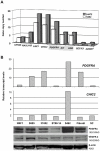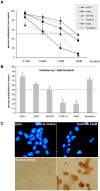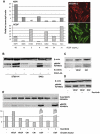The 4q12 amplicon in malignant peripheral nerve sheath tumors: consequences on gene expression and implications for sunitinib treatment
- PMID: 20686603
- PMCID: PMC2912277
- DOI: 10.1371/journal.pone.0011858
The 4q12 amplicon in malignant peripheral nerve sheath tumors: consequences on gene expression and implications for sunitinib treatment
Abstract
Background: Malignant peripheral nerve sheath tumors (MPNST) are highly aggressive tumors which originate from Schwann cells and develop in about 10% of neurofibromatosis type 1 (NF1) patients. The five year survival rate is poor and more effective therapies are needed. Sunitinib is a drug targeting receptor tyrosine kinases (RTK) like PDGFRalpha, c-Kit and VEGFR-2. These genes are structurally related and cluster on chromosomal segment 4q12.
Methodology/principal findings: Here we characterize this region by multiplex ligation-dependent probe amplification (MLPA) in MPNST. Our probe set encompasses the 3 adjacent RTK genes (PDGFRA, KIT, KDR) and 6 flanking genes. We found amplification of several genes within this region in a subset of MPNST and MPNST cell lines. Transcript and protein expression of PDGFRA matched well with its increased copy number suggesting a central role of PDGFRA within the amplicon. Studying the effect of sunitinib on 5 MPNST cell lines revealed that cell line S462 harboring the 4q12 amplicon was extremely sensitive to the drug with an IC50 below 1.0 microM. Moreover, sunitinib induced apoptosis and prevented PDGF-AA induced signaling via PDGFRalpha as determined by western blotting. Co-expression of VEGF and its receptor VEGFR-2 (KDR) was present in MPNST cell lines suggesting an autocrine loop. We show that VEGF triggered signal transduction via the MAPK pathway, which could be blocked by sunitinib.
Conclusions/significance: Since multiple receptors targeted by sunitinib are expressed or over-expressed by MPNST cells sunitinib appears as an attractive drug for treatment of MPNST patients. Presence of the 4q12 amplicon and subsequent over-expression of PDGFRA might serve as predictive markers for efficacy of sunitinib.
Conflict of interest statement
Figures




Similar articles
-
Mutation and expression of PDGFRA and KIT in malignant peripheral nerve sheath tumors, and its implications for imatinib sensitivity.Carcinogenesis. 2006 Mar;27(3):664-71. doi: 10.1093/carcin/bgi273. Epub 2005 Dec 15. Carcinogenesis. 2006. PMID: 16357008
-
PDGFRA, PDGFRB, EGFR, and downstream signaling activation in malignant peripheral nerve sheath tumor.Neuro Oncol. 2009 Dec;11(6):725-36. doi: 10.1215/15228517-2009-003. Neuro Oncol. 2009. PMID: 19246520 Free PMC article.
-
Schwann cell lines derived from malignant peripheral nerve sheath tumors respond abnormally to platelet-derived growth factor-BB.J Neurosci Res. 2005 Feb 1;79(3):318-28. doi: 10.1002/jnr.20334. J Neurosci Res. 2005. PMID: 15602756
-
Implications of mutational analysis for the management of patients with gastrointestinal stromal tumors and the application of targeted therapies.Cancer Invest. 2010 Oct;28(8):839-48. doi: 10.3109/07357907.2010.494322. Cancer Invest. 2010. PMID: 20690803 Review.
-
Sunitinib, a multitargeted tyrosine kinase inhibitor, in the management of gastrointestinal stromal tumor.Curr Oncol Rep. 2007 Jul;9(4):323-7. doi: 10.1007/s11912-007-0040-1. Curr Oncol Rep. 2007. PMID: 17588358 Review.
Cited by
-
The Challenge of Cancer Genomics in Rare Nervous System Neoplasms: Malignant Peripheral Nerve Sheath Tumors as a Paradigm for Cross-Species Comparative Oncogenomics.Am J Pathol. 2016 Mar;186(3):464-77. doi: 10.1016/j.ajpath.2015.10.023. Epub 2015 Dec 28. Am J Pathol. 2016. PMID: 26740486 Free PMC article. Review.
-
Zebrafish Cancer Predisposition Models.Front Cell Dev Biol. 2021 Apr 27;9:660069. doi: 10.3389/fcell.2021.660069. eCollection 2021. Front Cell Dev Biol. 2021. PMID: 33987182 Free PMC article. Review.
-
H3K27me3 expression and methylation status in histological variants of malignant peripheral nerve sheath tumours.J Pathol. 2020 Oct;252(2):151-164. doi: 10.1002/path.5507. Epub 2020 Sep 1. J Pathol. 2020. PMID: 32666581 Free PMC article.
-
Comparative oncogenomic analysis of copy number alterations in human and zebrafish tumors enables cancer driver discovery.PLoS Genet. 2013 Aug;9(8):e1003734. doi: 10.1371/journal.pgen.1003734. Epub 2013 Aug 29. PLoS Genet. 2013. PMID: 24009526 Free PMC article.
-
Drug sensitivity and resistance testing identifies PLK1 inhibitors and gemcitabine as potent drugs for malignant peripheral nerve sheath tumors.Mol Oncol. 2017 Sep;11(9):1156-1171. doi: 10.1002/1878-0261.12086. Epub 2017 Jul 5. Mol Oncol. 2017. PMID: 28556483 Free PMC article.
References
-
- von Deimling A, Krone W, Menon A. Neurofibromatosis Type 1: Pathology, clinical features and molecular genetics. Brain Pathology. 1995;5:153–162. - PubMed
-
- Holtkamp N, Okuducu AF, Mucha J, Afanasieva A, Hartmann C, et al. Mutation and expression of PDGFRA and KIT in malignant peripheral nerve sheath tumors, and its implications for imatinib sensitivity. Carcinogenesis. 2006;27:664–671. - PubMed
-
- Joensuu H, Puputti M, Sihto H, Tynninen O, Nupponen NN. Amplification of genes encoding KIT, PDGFRalpha and VEGFR2 receptor tyrosine kinases is frequent in glioblastoma multiforme. J Pathol. 2005;207:224–231. - PubMed
-
- McIntyre A, Summersgill B, Grygalewicz B, Gillis AJ, Stoop J, et al. Amplification and overexpression of the KIT gene is associated with progression in the seminoma subtype of testicular germ cell tumors of adolescents and adults. Cancer Res. 2005;65:8085–8089. - PubMed
Publication types
MeSH terms
Substances
LinkOut - more resources
Full Text Sources
Research Materials
Miscellaneous

